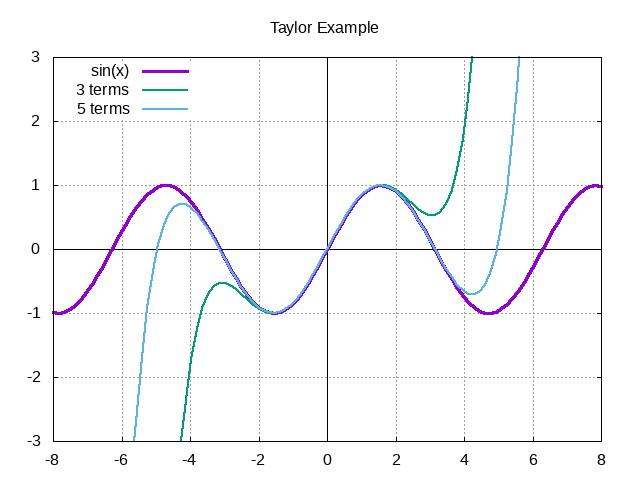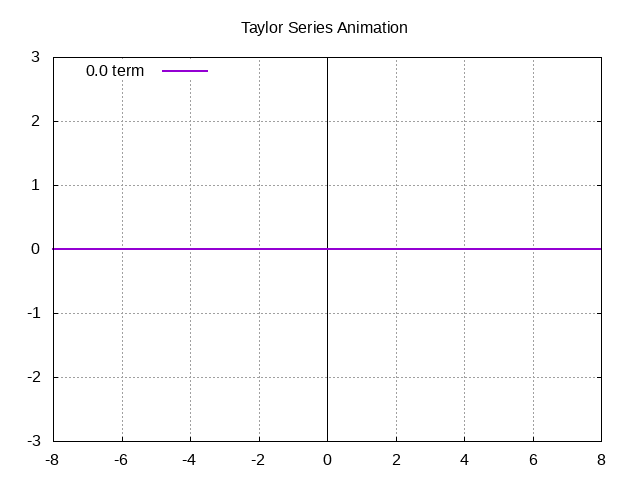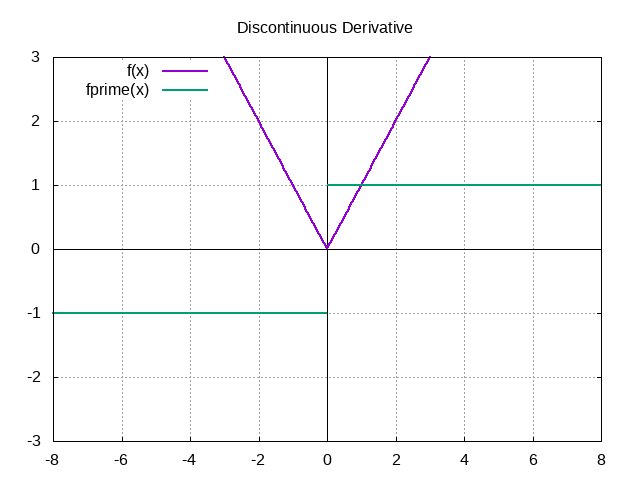An overview of Taylor series
A fourier expansion is a way for us to approximate a function. If you've taken calculus before, you may have heard of a similar concept, Taylor series. With Taylor series, we can approximate any function as a sum of polynomials. For example, we can write as
If we were to graph this, we see that as more terms are added, our approximation becomes more and more accurate. Here's a small demonstration.

In the graph below, I tried demonstrating how the Taylor series can "home in" on a function. Since we can't add part of a term in a Taylor series, I tried to demonstrate this effect by multiplying the term by a value. For example, when you see 1.1 terms, that means the first term + 0.1 * the second term. For , that's .

Now, Taylor series can be useful, but they have significant limitations. First, we see that the Taylor series does a poor job modeling periodic functions. Even though repeats, our Taylor series does not. At large values, this Taylor series is completely wrong!
Second, a Taylor series relies on the function being continuous (no holes or jumps). In addition to the function being continous, its derivatives must be as well. Let's consider the following graph.

Even though is continuous, its derivative is not. As such, a Taylor series cannot be used to approximate this function. This issue would come up even if was discontinuous. (Keep in mind that discontinuous is not the same thing as 0! We can model as a Taylor series, as its higher order derivatives are continuous. They just also happen to be 0. Also, is its own Taylor series.)
So, to summarize, Taylor series have the following issues:
They do not model periodic functions well
They require the function and all of its derivatives to be continuous
Fortunately, the Fourier series provides answers to both of these problems! (At least for most functions. Some functions, like a function that is discontinuous everywhere, exist solely for the purpose of making us sad.)
What we're all here for, Fourier series
I'll be sticking to the basics of Fourier series for now. Let's assume we have a periodic function that has a period of . I am going to fintroduce the symbol l-i where . While this isn't the only option, we can write the Fourier series as
In this case, we can find and with the formulas
I won't go into detail as to where these formulas come from. (That is left as an exercise for the reader. Hah!) However, I will point out that we can adjust the limits of integration to any values we want, just as long as the difference between the upper and lower limits equals our period.
There is one special case that we need to discuss. When , we need a new formula for . This formula will look like
Fortunately there is no special case for . This occurs due to the fact that is a constant term ( ) as opposed to periodic.
That is all the theory that we need to calculate the Fourier series! As long as we can find a library that can perform integration for us, we should be able to calculate the Fourier series for any periodic function.
Using GSL to calculate an integral
Explanation of gsl_integration_qng()
Because of inscrutible magic mumbo jumbo, I decided to use C for
calculating the Fourier expansion. In order to do that, I needed to
pick out a library that could perform the integration for me. I
settled on GSL or the GNU Scientific Library. There are many, many,
MANY functions available in this library, but luckily I only need to
worry about integration.
Before going too far into Fourier stuff, I'm going to do a simple sanity check so I can make sure I'm calculating integrals correctly. I want to calculate the following integral.
To do this using GSL, I can use the gsl_integration_qng() function.
This function has the following signature.
int gsl_integration_qng(const gsl_function * f,
double a, double b,
double epsabs, double epsrel,
double * result, double * abserr,
size_t * neval)f is a pointer to a structure that contains a function pointer. For
those who don't speak nerd, this is how gsl-integration-qng() knows
what function to integrate. It's our f(x). (Mostly. The reason for
making it a structure is because the structure also contains a void * or void pointer. This void pointer can be used to pass parameters
to the function. This could be used to let us change the slope of the
function without having to modify the function itself.
a and b are the lower and upper limits of integration.
That's fairly straightforward.
epsabs and epsrel help gsl_integration_qng() decide when to stop
integrating. It's not possible to integrate the function to an exact
value with GSL. Instead, it tries to zero in on a specific value or
best guess as to what the answer is. epsabs is the absolute error
that we want. If epsabs = 0.1, we don't know what the answer is, but
we know we are no more than 0.1 away from it. epsrel is similar, but
percentage based instead of absolute. (e.g. epsrel = 0.01 means our
answer is within 1% of the actual value.)
result and abserr are used by the function to store the result
and estimated absolute error, respectively. The number of iterations
it took to calculate the result is stored in neval.
It is possible for the integration to fail. This might happen if we set the error tolerances too tight. Since the function we're integrating is so simple, I don't think that's a likely concern.
gsl_integration_qng() in use
To compile this program, you will need to tell the compiler what
external libraries to use. You can do with with the -lgsl compile
flag, e.g. gcc main.c -lgsl. Because GSL depends on another
library, CBLAS, you will also need the -lcblas flag. If CBLAS
isn't available, you can use a version of CBLAS provided by GSL
with -lgslcblas. (Don't forget to install GSL!) Since I'm using
some math function, I'm also going to include the math library with
-lm.
In the end, our command will look like gcc main.c -lgsl -lcblas -lm,
which will compile main.c and create an output file a.out.
(Actually I'm using org-babel so I don't have to deal with this, but
I'm assuming most readers here are not.)
Alright! Time to integrate! I need to preface the gsl_integration.h
header with gsl/ as the headers are installed in a gsl
subdirectory. (If you installed this through your systems package
manager, you can probably find this file in /usr/include/gsl/.)
#include <stdio.h>
#include <gsl/gsl_integration.h>
#include <math.h>
/* This is where we define the function */
double f(double x, void *params) {
return x;
}
int main() {
double result, error;
double low = 0, high = 8;
gsl_function F = {.function = &f};
double err_abs = 0, err_rel = 1;
size_t num_evals;
gsl_integration_qng(&F, low, high, err_abs, err_rel,
&result, &error, &num_evals);
printf("result error num_evals\n");
printf("%f %f %zu\n", result, error, num_evals);
}Results:
| result | error | num_evals |
| 32.0 | 0.0 | 21 |There we go! GSL was able to successfully integrate .
In the next part, we'll start using GSL to calculate the Fourier
series of a discontinuous, periodic function. We'll see if we can
naively get away with using the simple gsl_integration_qng()
function, or if we need to find a more complicated, but more powerful, alternative.